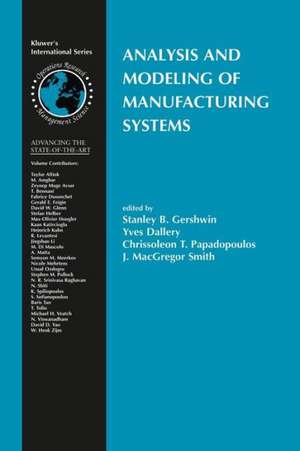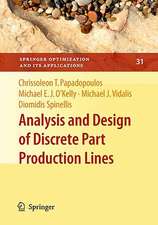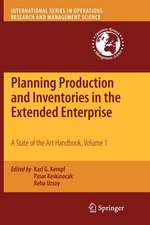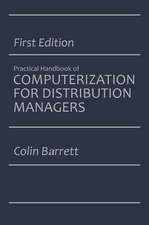Analysis and Modeling of Manufacturing Systems: International Series in Operations Research & Management Science, cartea 60
Editat de Stanley B. Gershwin, Yves Dallery, Chrissoleon T. Papadopoulos, J. MacGregor Smithen Limba Engleză Paperback – 31 oct 2012
Analysis and Modeling of Manufacturing Systems will be of interest to readers with a strong background in operations research, including researchers and mathematically sophisticated practitioners.
| Toate formatele și edițiile | Preț | Express |
|---|---|---|
| Paperback (1) | 1327.88 lei 43-57 zile | |
| Springer Us – 31 oct 2012 | 1327.88 lei 43-57 zile | |
| Hardback (1) | 1330.25 lei 43-57 zile | |
| Springer Us – 30 noi 2002 | 1330.25 lei 43-57 zile |
Din seria International Series in Operations Research & Management Science
- 20%
 Preț: 331.25 lei
Preț: 331.25 lei - 9%
 Preț: 696.06 lei
Preț: 696.06 lei - 20%
 Preț: 570.62 lei
Preț: 570.62 lei - 18%
 Preț: 1132.02 lei
Preț: 1132.02 lei - 18%
 Preț: 773.72 lei
Preț: 773.72 lei -
 Preț: 170.40 lei
Preț: 170.40 lei - 17%
 Preț: 459.35 lei
Preț: 459.35 lei - 17%
 Preț: 360.48 lei
Preț: 360.48 lei -
 Preț: 263.40 lei
Preț: 263.40 lei - 24%
 Preț: 905.31 lei
Preț: 905.31 lei - 17%
 Preț: 460.09 lei
Preț: 460.09 lei - 17%
 Preț: 459.35 lei
Preț: 459.35 lei - 20%
 Preț: 631.58 lei
Preț: 631.58 lei - 13%
 Preț: 480.01 lei
Preț: 480.01 lei - 18%
 Preț: 738.28 lei
Preț: 738.28 lei - 18%
 Preț: 1225.94 lei
Preț: 1225.94 lei - 18%
 Preț: 948.92 lei
Preț: 948.92 lei - 18%
 Preț: 703.88 lei
Preț: 703.88 lei - 18%
 Preț: 957.44 lei
Preț: 957.44 lei - 15%
 Preț: 651.84 lei
Preț: 651.84 lei - 20%
 Preț: 336.21 lei
Preț: 336.21 lei - 15%
 Preț: 641.03 lei
Preț: 641.03 lei -
 Preț: 404.29 lei
Preț: 404.29 lei - 18%
 Preț: 950.21 lei
Preț: 950.21 lei - 15%
 Preț: 649.06 lei
Preț: 649.06 lei - 18%
 Preț: 725.75 lei
Preț: 725.75 lei -
 Preț: 394.12 lei
Preț: 394.12 lei - 18%
 Preț: 951.47 lei
Preț: 951.47 lei - 15%
 Preț: 639.59 lei
Preț: 639.59 lei - 18%
 Preț: 773.06 lei
Preț: 773.06 lei - 18%
 Preț: 889.29 lei
Preț: 889.29 lei - 15%
 Preț: 655.60 lei
Preț: 655.60 lei - 15%
 Preț: 640.06 lei
Preț: 640.06 lei
Preț: 1327.88 lei
Preț vechi: 1619.37 lei
-18% Nou
Puncte Express: 1992
Preț estimativ în valută:
254.17€ • 276.18$ • 213.64£
254.17€ • 276.18$ • 213.64£
Carte tipărită la comandă
Livrare economică 21 aprilie-05 mai
Preluare comenzi: 021 569.72.76
Specificații
ISBN-13: 9781461353546
ISBN-10: 1461353548
Pagini: 456
Ilustrații: XXIII, 429 p.
Dimensiuni: 155 x 235 x 24 mm
Greutate: 0.64 kg
Ediția:2003
Editura: Springer Us
Colecția Springer
Seria International Series in Operations Research & Management Science
Locul publicării:New York, NY, United States
ISBN-10: 1461353548
Pagini: 456
Ilustrații: XXIII, 429 p.
Dimensiuni: 155 x 235 x 24 mm
Greutate: 0.64 kg
Ediția:2003
Editura: Springer Us
Colecția Springer
Seria International Series in Operations Research & Management Science
Locul publicării:New York, NY, United States
Public țintă
ResearchCuprins
1 Capacitated Two-Echelon Inventory Models for Repairable Item Systems.- 1 Introduction.- 2 Analysis of a simple two-echelon system with central repair.- 3 General capacitated two-echelon repairable item systems.- 4 Optimization.- 5 Summary.- 2 Distribution Resource Planning Systems: A Critique and Enhancement.- 1 Introduction.- 2 How Does DRP Work?.- 3 Improved Projections: Lot-for-Lot Rule.- 4 The (S, s) Inventory System.- 5 Improved Projections: Dynamic (S, s) Rule.- 6 Numerical Examples.- 7 Concluding Remarks.- 8 Appendix: Setting Safety Stock Levels.- 3 Process Adjustment for Assemblies.- 1 Single Tool Adjustment with Uncertainty.- 2 Combined Policy for Adjustment of Two Tools.- 3 Conclusion.- 4 Exact Analysis of a Continuous Material Merge System with Limited Buffer Capacity and Three Stations.- 1 Introduction.- 2 Derivation of Transition Equations.- 3 Numerical Results.- 4 Conclusion.- Appendix: Details of the Derivation and the Algorithm.- 5 Optimal scheduling for piecewise deterministic Multi-Armed Bandit Problem.- 1 Introduction.- 2 Classical Multi-armed Bandit problems. A brief overview..- 3 Optimal stopping for piecewise deterministic processes..- 4 Illustration for the manufacturing context.- 5 Conclusion and perspectives.- 6 Production Planning for Short Life-Cycle Products in Consideration of Clearance Sale.- 1 Introduction.- 2 Numerical formulae.- 3 Numerical example.- 4 Conclusions.- 7 Analysis of Automated Flow Line Systems with Repair Crew Interference.- 1 Model of the production and repair system.- 2 Iterative solution procedure.- 3 Integrative solution approach.- 4 Results.- 8 Performance Evaluation of Production Lines with Random Processing Times, Multiple Failure Modes and Finite Buffer Capacity — Part I: The Building Block.- 1 Introduction.- 2Model Description and Assumptions.- 3 Numerical Results.- 4 Conclusions.- Appendix: Transient States.- Appendix: Roots of the polynomial are real.- Appendix: Solution of Internal Equations Implies CR = 0.- 9 Performance Evaluation of Production Lines with Random Processing Times, Multiple Failure Modes and Finite Buffer Capacity — Part II: The Decomposition.- 1 Introduction.- 2 Model Description and Assumptions.- 3 Machine Behavior.- 4 Performance Measures.- 5 Outline of the Method.- 6 Decomposition Equations.- 7 Numerical Results.- 8 Conclusions.- 10 Due-time Performance of Production Systems with Markovian Machines.- 1 Motivation.- 2 Problem Formulation.- 3 Production Rate Evaluation.- 4 DTP Calculation.- 5 Structural Properties.- 6 Conclusions.- Appendix: Proofs.- 11 Analysis of Two-Valve Fluid-Flow Systems with General Repair Times.- 1 Introduction.- 2 The Model.- 3 Solution Approach.- 4 Model Verification.- 5 Impact of Repair Time Variability.- 6 Conclusion.- 12 Stochastic Lead Time Models for Supply Chain Networks.- 1 Supply Chain Networks.- 2 Lead Time Models.- 3 Lead Time Models for Performance Analysis.- 4 Generalized Queueing Network Models.- 5 Conclusions.- 13 Modeling and Performance Evaluation of Base-Stock Controlled Assem-bly Systems.- 1 Introduction.- 2 Base-Stock Controlled Assembly Systems.- 3 Modeling.- 4 Analysis.- 5 Performance Evaluation.- 6 Generalization to More than 3 Stages.- 7 Numerical Results.- 8 Generalization to the Assembly of More than Two Products.- 9 Conclusion.- 14 Designing Manufacturing Cells Using a Tabu Search Approach.- 1 Introduction.- 2 Problem Statement.- 3 Definitions - the Basic Element s of the Tabu Search Framework.- 4 The Search Strategy.- 5 Computational Results.- 6 Conclusions.- 15 State-Space Modeling and Analysisof Pull-Controlled Production Systems.- 1 Introduction.- 2 General Structure.- 3 Model Builder.- 4 Model.- 5 An Algorithm to Generate the State Space Models.- 6 Automated Transfer Lines Controlled by Pull Policies.- 7 Performance Evaluation Block.- 8 Numerical Results and Extensions.- 9 Conclusions.- 16 Using Fluid Solutions in Dynamic Scheduling.- 1 Introduction.- 2 The Discrete and Fluid Models.- 3 Greedy Solutions.- 4 Fluid Limits and Asymptotic Switching Curves.- 5 Conclusion.- 6 Acknowledgments.



















